Effective Overhead Management Strategies for Defense Contracts
VerifiedAdded on 2020/05/28
|6
|895
|78
Report
AI Summary
This report delves into the critical aspects of overhead management within the context of defense contracts. It begins by defining overhead costs as indirect expenses essential for manufacturing and production, encompassing inventory management, warehousing, and facility costs. The report emphasizes the importance of effective overhead cost management in defense contracts due to their confidential nature and the involvement of the U.S. federal government. It highlights the need for proper acquisition planning, contract formation, and cost allocation strategies to ensure successful service delivery and efficient use of funding. The analysis covers various types of overhead pools, including manufacturing, material, and personnel-related costs, and underscores the significance of adhering to cost accounting standards and federal acquisition regulations. The report concludes by providing a formula for calculating indirect costs and a method for determining the percentage of overhead costs, offering a comprehensive overview of the subject matter.
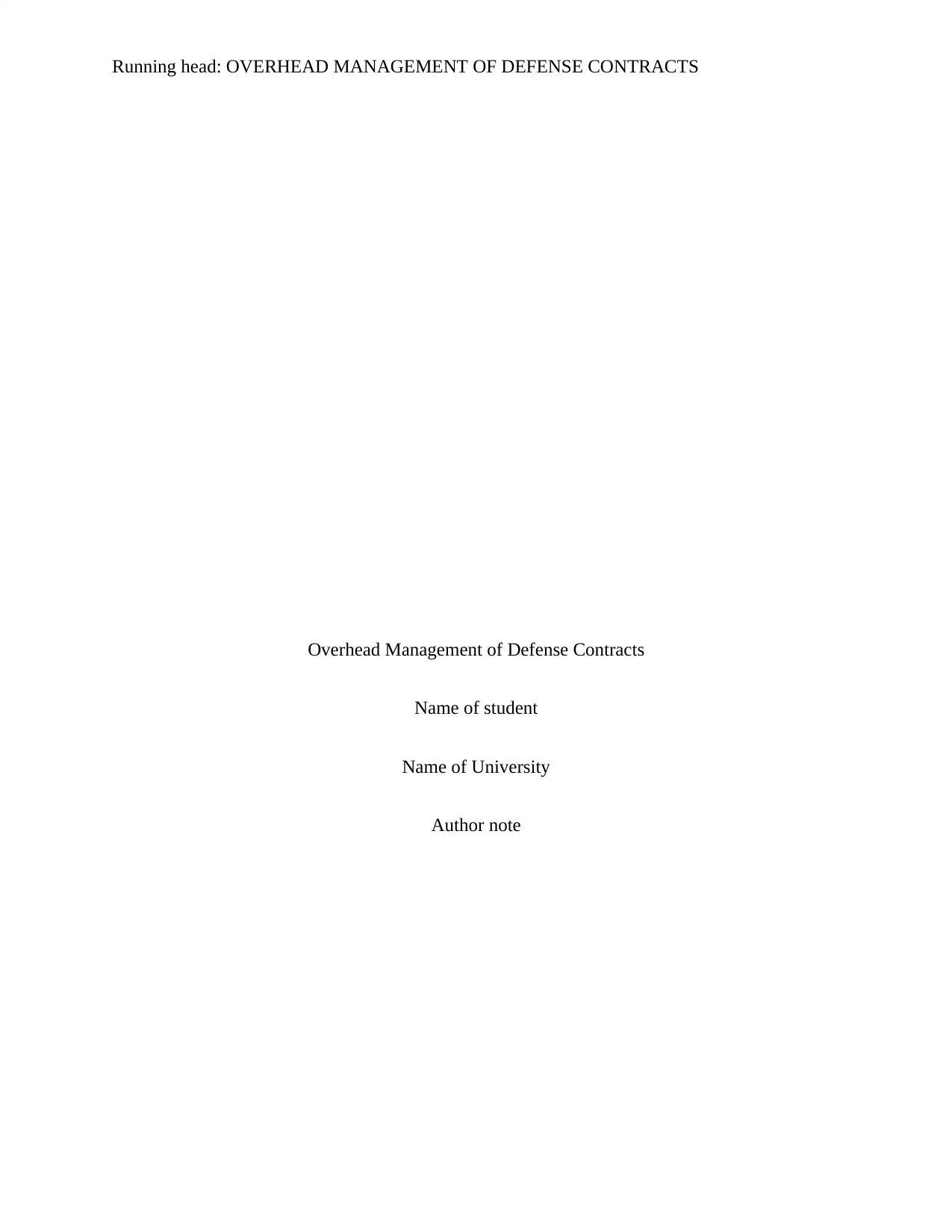
Running head: OVERHEAD MANAGEMENT OF DEFENSE CONTRACTS
Overhead Management of Defense Contracts
Name of student
Name of University
Author note
Overhead Management of Defense Contracts
Name of student
Name of University
Author note
Paraphrase This Document
Need a fresh take? Get an instant paraphrase of this document with our AI Paraphraser
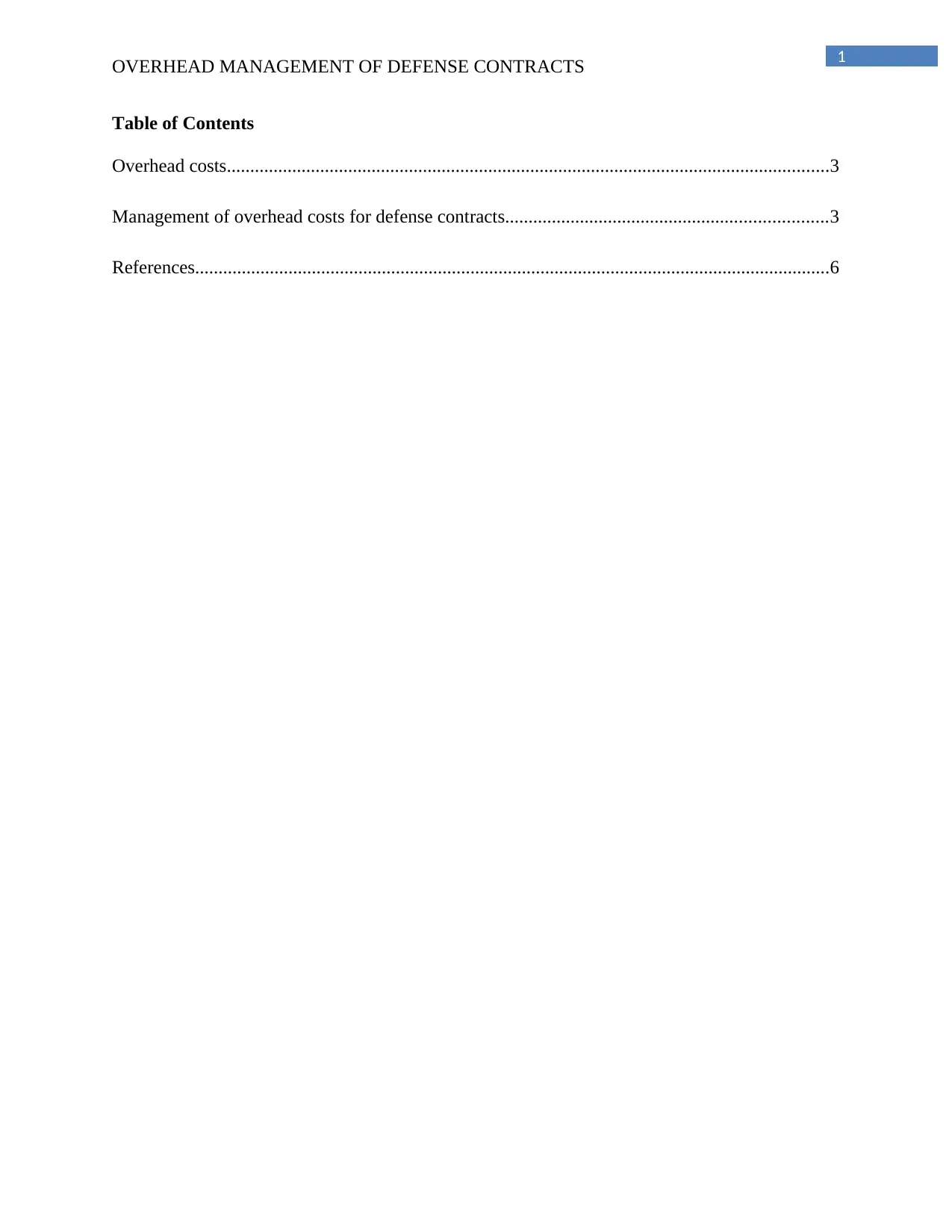
1
OVERHEAD MANAGEMENT OF DEFENSE CONTRACTS
Table of Contents
Overhead costs.................................................................................................................................3
Management of overhead costs for defense contracts.....................................................................3
References........................................................................................................................................6
OVERHEAD MANAGEMENT OF DEFENSE CONTRACTS
Table of Contents
Overhead costs.................................................................................................................................3
Management of overhead costs for defense contracts.....................................................................3
References........................................................................................................................................6
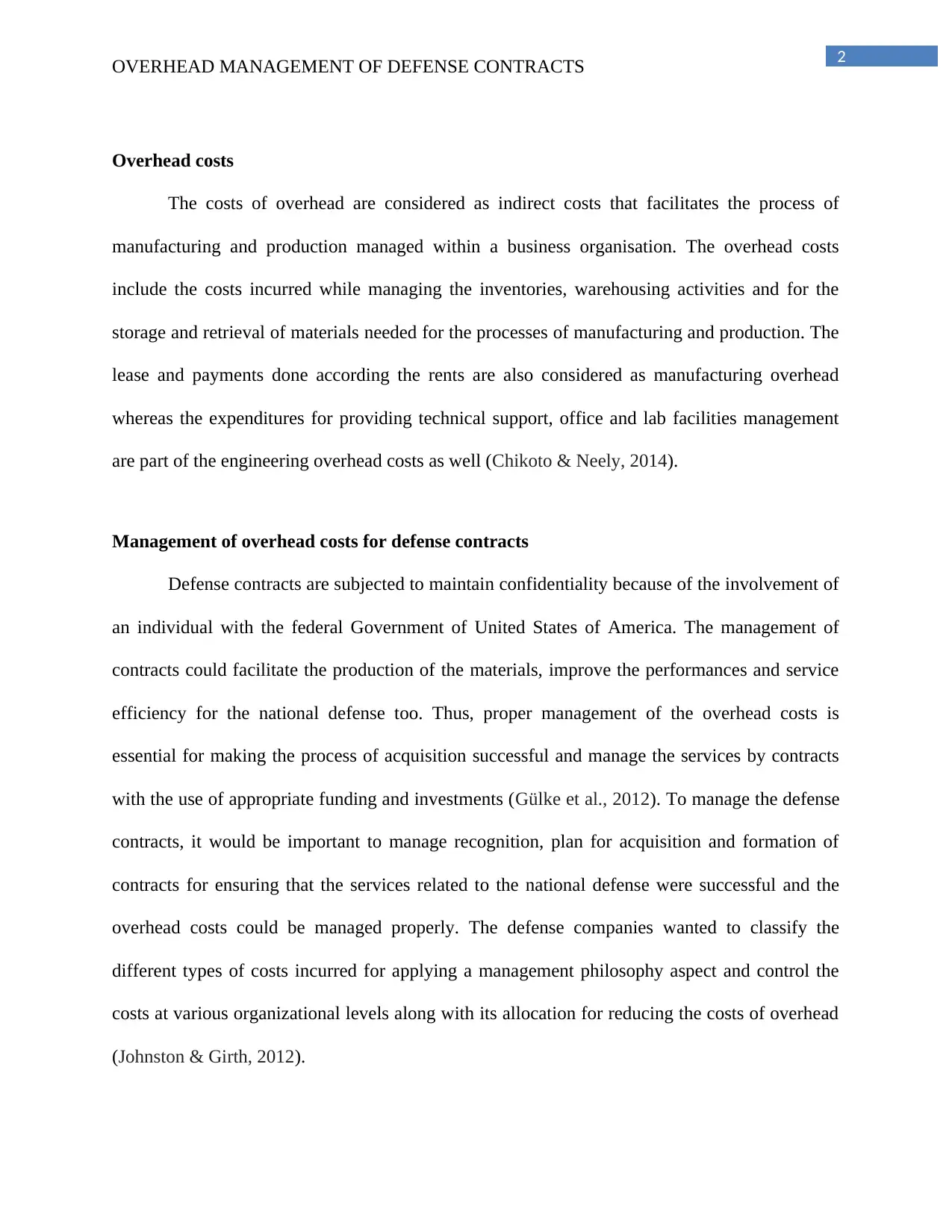
2
OVERHEAD MANAGEMENT OF DEFENSE CONTRACTS
Overhead costs
The costs of overhead are considered as indirect costs that facilitates the process of
manufacturing and production managed within a business organisation. The overhead costs
include the costs incurred while managing the inventories, warehousing activities and for the
storage and retrieval of materials needed for the processes of manufacturing and production. The
lease and payments done according the rents are also considered as manufacturing overhead
whereas the expenditures for providing technical support, office and lab facilities management
are part of the engineering overhead costs as well (Chikoto & Neely, 2014).
Management of overhead costs for defense contracts
Defense contracts are subjected to maintain confidentiality because of the involvement of
an individual with the federal Government of United States of America. The management of
contracts could facilitate the production of the materials, improve the performances and service
efficiency for the national defense too. Thus, proper management of the overhead costs is
essential for making the process of acquisition successful and manage the services by contracts
with the use of appropriate funding and investments (Gülke et al., 2012). To manage the defense
contracts, it would be important to manage recognition, plan for acquisition and formation of
contracts for ensuring that the services related to the national defense were successful and the
overhead costs could be managed properly. The defense companies wanted to classify the
different types of costs incurred for applying a management philosophy aspect and control the
costs at various organizational levels along with its allocation for reducing the costs of overhead
(Johnston & Girth, 2012).
OVERHEAD MANAGEMENT OF DEFENSE CONTRACTS
Overhead costs
The costs of overhead are considered as indirect costs that facilitates the process of
manufacturing and production managed within a business organisation. The overhead costs
include the costs incurred while managing the inventories, warehousing activities and for the
storage and retrieval of materials needed for the processes of manufacturing and production. The
lease and payments done according the rents are also considered as manufacturing overhead
whereas the expenditures for providing technical support, office and lab facilities management
are part of the engineering overhead costs as well (Chikoto & Neely, 2014).
Management of overhead costs for defense contracts
Defense contracts are subjected to maintain confidentiality because of the involvement of
an individual with the federal Government of United States of America. The management of
contracts could facilitate the production of the materials, improve the performances and service
efficiency for the national defense too. Thus, proper management of the overhead costs is
essential for making the process of acquisition successful and manage the services by contracts
with the use of appropriate funding and investments (Gülke et al., 2012). To manage the defense
contracts, it would be important to manage recognition, plan for acquisition and formation of
contracts for ensuring that the services related to the national defense were successful and the
overhead costs could be managed properly. The defense companies wanted to classify the
different types of costs incurred for applying a management philosophy aspect and control the
costs at various organizational levels along with its allocation for reducing the costs of overhead
(Johnston & Girth, 2012).
⊘ This is a preview!⊘
Do you want full access?
Subscribe today to unlock all pages.

Trusted by 1+ million students worldwide
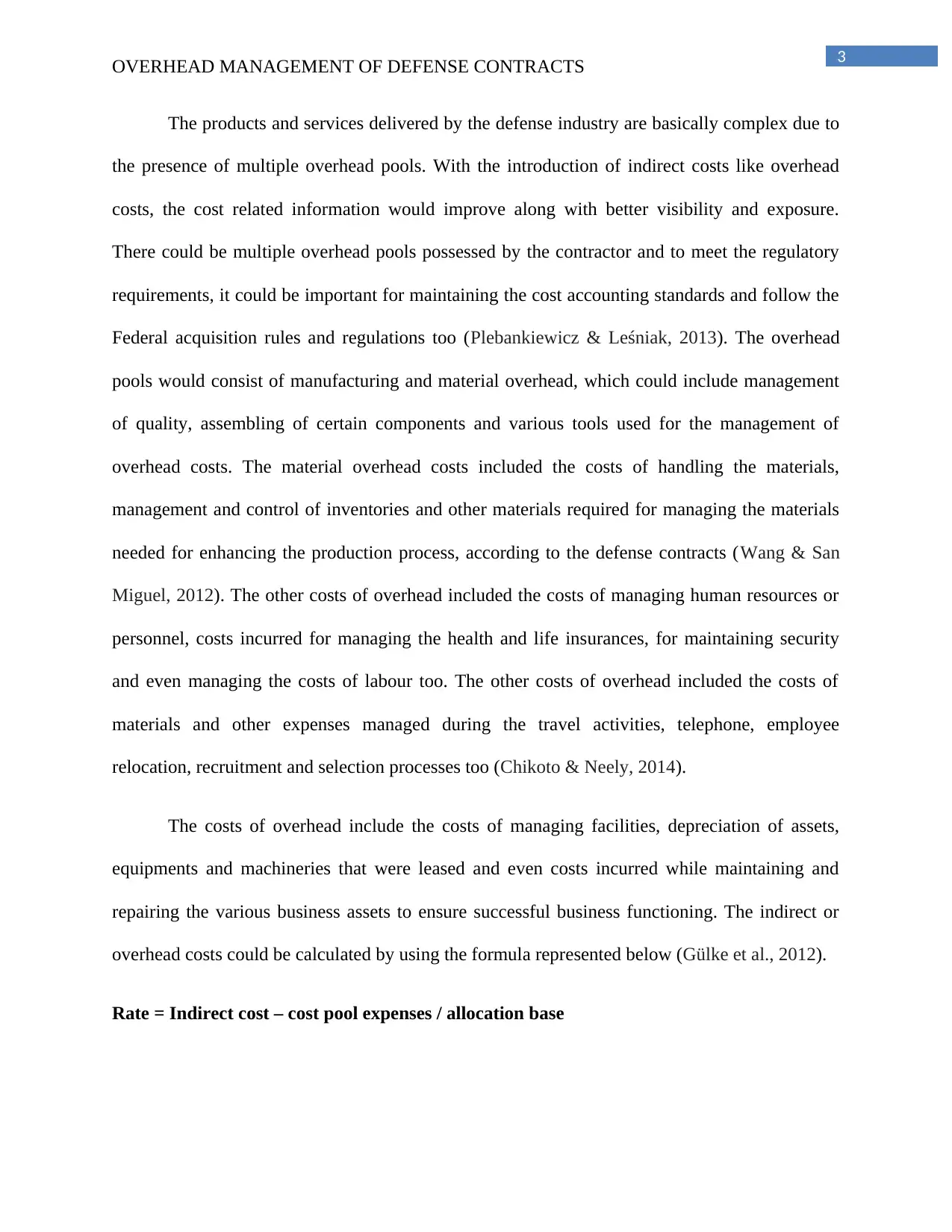
3
OVERHEAD MANAGEMENT OF DEFENSE CONTRACTS
The products and services delivered by the defense industry are basically complex due to
the presence of multiple overhead pools. With the introduction of indirect costs like overhead
costs, the cost related information would improve along with better visibility and exposure.
There could be multiple overhead pools possessed by the contractor and to meet the regulatory
requirements, it could be important for maintaining the cost accounting standards and follow the
Federal acquisition rules and regulations too (Plebankiewicz & Leśniak, 2013). The overhead
pools would consist of manufacturing and material overhead, which could include management
of quality, assembling of certain components and various tools used for the management of
overhead costs. The material overhead costs included the costs of handling the materials,
management and control of inventories and other materials required for managing the materials
needed for enhancing the production process, according to the defense contracts (Wang & San
Miguel, 2012). The other costs of overhead included the costs of managing human resources or
personnel, costs incurred for managing the health and life insurances, for maintaining security
and even managing the costs of labour too. The other costs of overhead included the costs of
materials and other expenses managed during the travel activities, telephone, employee
relocation, recruitment and selection processes too (Chikoto & Neely, 2014).
The costs of overhead include the costs of managing facilities, depreciation of assets,
equipments and machineries that were leased and even costs incurred while maintaining and
repairing the various business assets to ensure successful business functioning. The indirect or
overhead costs could be calculated by using the formula represented below (Gülke et al., 2012).
Rate = Indirect cost – cost pool expenses / allocation base
OVERHEAD MANAGEMENT OF DEFENSE CONTRACTS
The products and services delivered by the defense industry are basically complex due to
the presence of multiple overhead pools. With the introduction of indirect costs like overhead
costs, the cost related information would improve along with better visibility and exposure.
There could be multiple overhead pools possessed by the contractor and to meet the regulatory
requirements, it could be important for maintaining the cost accounting standards and follow the
Federal acquisition rules and regulations too (Plebankiewicz & Leśniak, 2013). The overhead
pools would consist of manufacturing and material overhead, which could include management
of quality, assembling of certain components and various tools used for the management of
overhead costs. The material overhead costs included the costs of handling the materials,
management and control of inventories and other materials required for managing the materials
needed for enhancing the production process, according to the defense contracts (Wang & San
Miguel, 2012). The other costs of overhead included the costs of managing human resources or
personnel, costs incurred for managing the health and life insurances, for maintaining security
and even managing the costs of labour too. The other costs of overhead included the costs of
materials and other expenses managed during the travel activities, telephone, employee
relocation, recruitment and selection processes too (Chikoto & Neely, 2014).
The costs of overhead include the costs of managing facilities, depreciation of assets,
equipments and machineries that were leased and even costs incurred while maintaining and
repairing the various business assets to ensure successful business functioning. The indirect or
overhead costs could be calculated by using the formula represented below (Gülke et al., 2012).
Rate = Indirect cost – cost pool expenses / allocation base
Paraphrase This Document
Need a fresh take? Get an instant paraphrase of this document with our AI Paraphraser

4
OVERHEAD MANAGEMENT OF DEFENSE CONTRACTS
The percentage of overhead cost could be calculated by dividing the cost of overhead
monthly with the sales level achieved on a monthly basis and then multiplying it by 100.
OVERHEAD MANAGEMENT OF DEFENSE CONTRACTS
The percentage of overhead cost could be calculated by dividing the cost of overhead
monthly with the sales level achieved on a monthly basis and then multiplying it by 100.
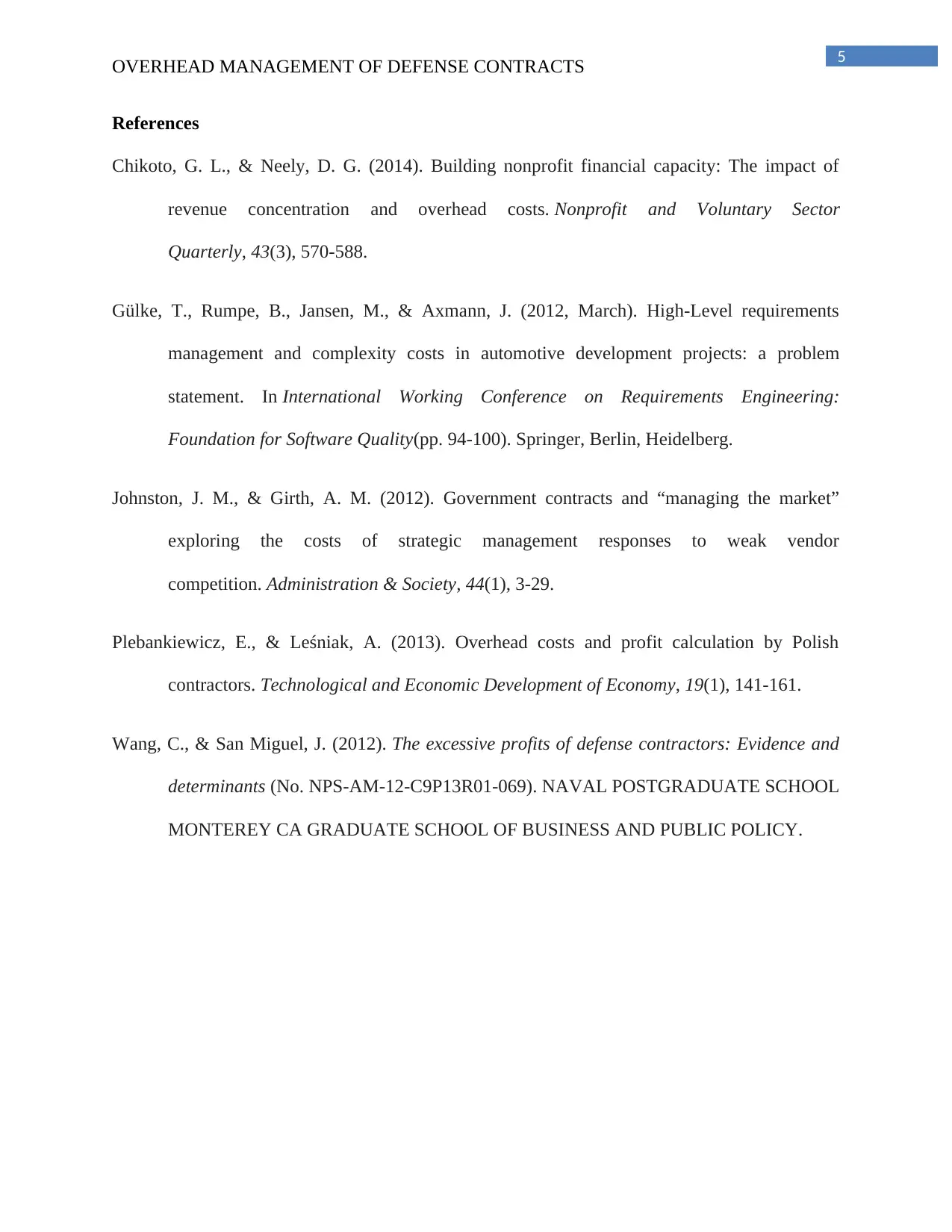
5
OVERHEAD MANAGEMENT OF DEFENSE CONTRACTS
References
Chikoto, G. L., & Neely, D. G. (2014). Building nonprofit financial capacity: The impact of
revenue concentration and overhead costs. Nonprofit and Voluntary Sector
Quarterly, 43(3), 570-588.
Gülke, T., Rumpe, B., Jansen, M., & Axmann, J. (2012, March). High-Level requirements
management and complexity costs in automotive development projects: a problem
statement. In International Working Conference on Requirements Engineering:
Foundation for Software Quality(pp. 94-100). Springer, Berlin, Heidelberg.
Johnston, J. M., & Girth, A. M. (2012). Government contracts and “managing the market”
exploring the costs of strategic management responses to weak vendor
competition. Administration & Society, 44(1), 3-29.
Plebankiewicz, E., & Leśniak, A. (2013). Overhead costs and profit calculation by Polish
contractors. Technological and Economic Development of Economy, 19(1), 141-161.
Wang, C., & San Miguel, J. (2012). The excessive profits of defense contractors: Evidence and
determinants (No. NPS-AM-12-C9P13R01-069). NAVAL POSTGRADUATE SCHOOL
MONTEREY CA GRADUATE SCHOOL OF BUSINESS AND PUBLIC POLICY.
OVERHEAD MANAGEMENT OF DEFENSE CONTRACTS
References
Chikoto, G. L., & Neely, D. G. (2014). Building nonprofit financial capacity: The impact of
revenue concentration and overhead costs. Nonprofit and Voluntary Sector
Quarterly, 43(3), 570-588.
Gülke, T., Rumpe, B., Jansen, M., & Axmann, J. (2012, March). High-Level requirements
management and complexity costs in automotive development projects: a problem
statement. In International Working Conference on Requirements Engineering:
Foundation for Software Quality(pp. 94-100). Springer, Berlin, Heidelberg.
Johnston, J. M., & Girth, A. M. (2012). Government contracts and “managing the market”
exploring the costs of strategic management responses to weak vendor
competition. Administration & Society, 44(1), 3-29.
Plebankiewicz, E., & Leśniak, A. (2013). Overhead costs and profit calculation by Polish
contractors. Technological and Economic Development of Economy, 19(1), 141-161.
Wang, C., & San Miguel, J. (2012). The excessive profits of defense contractors: Evidence and
determinants (No. NPS-AM-12-C9P13R01-069). NAVAL POSTGRADUATE SCHOOL
MONTEREY CA GRADUATE SCHOOL OF BUSINESS AND PUBLIC POLICY.
⊘ This is a preview!⊘
Do you want full access?
Subscribe today to unlock all pages.

Trusted by 1+ million students worldwide
1 out of 6
Related Documents
Your All-in-One AI-Powered Toolkit for Academic Success.
+13062052269
info@desklib.com
Available 24*7 on WhatsApp / Email
![[object Object]](/_next/static/media/star-bottom.7253800d.svg)
Unlock your academic potential
Copyright © 2020–2025 A2Z Services. All Rights Reserved. Developed and managed by ZUCOL.




